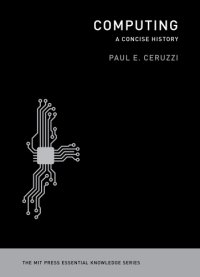
Ebook: Computing: a concise history
Author: Ceruzzi Paul E
- Tags: COMPUTER SCIENCE/General, SCIENCE TECHNOLOGY & SOCIETY/History of Technology, Computer science--History, COMPUTERS--Computer Literacy, COMPUTERS--Computer Science, COMPUTERS--Data Processing, COMPUTERS--Hardware--General, COMPUTERS--Information Technology, COMPUTERS--Machine Theory, COMPUTERS--Reference, Computer science, History, Electronic books, Computer science -- History, COMPUTERS -- Computer Literacy, COMPUTERS -- Computer Science, COMPUTERS -- Data Processing, COMPUTERS -- Hardware -- General, COMPUTERS
- Series: MIT Press essential knowledge series
- Year: 2012
- Publisher: MIT Press
- City: Cambridge;Mass
- Language: English
- epub
The history of computing could be told as the story of hardware and software, or the story of the Internet, or the story of "smart" hand-held devices, with subplots involving IBM, Microsoft, Apple, Facebook and Twitter. In this account of the invention and development of digital technology, the author, a computer historian, offers a broader and more useful perspective. He identifies four major threads running throughout all of computing's technological development: digitization, the coding of information, computation, and control in binary form, ones and zeros; the convergence of multiple streams of techniques, devices and machines, yielding more than the sum of their parts; the steady advance of electronic technology, as characterized famously by "Moore's Law"; and the human-machine interface. He guides us through computing history, telling how a Bell Labs mathematician coined the word "digital" in 1942 (to describe a high-speed method of calculating used in anti-aircraft devices), and recounting the development of the punch card (for use in the 1890 U.S. Census). He describes the ENIAC, built for scientific and military applications; the UNIVAC, the first general purpose computer; and ARPANET, the Internet's precursor. His account traces the world-changing evolution of the computer from a room-size ensemble of machinery to a "minicomputer" to a desktop computer to a pocket-sized smart phone. He describes the development of the silicon chip, which could store ever-increasing amounts of data and enabled ever-decreasing device size. He visits that hotbed of innovation, Silicon Valley, and brings the story up to the twenty-first century with the Internet, the World Wide Web, and social networking.;The digital age -- The first computers, 1935-1945 -- The stored program principle -- The chip and Silicon Valley -- The microprocessor -- The Internet and the World Wide Web -- Conclusion.
Download the book Computing: a concise history for free or read online
Continue reading on any device:

Last viewed books
Related books
{related-news}
Comments (0)